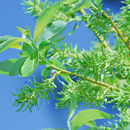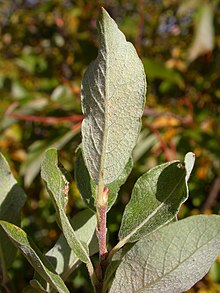fi
nimet breadcrumb-navigoinnissa


Bebb söyüdü (lat. Salix bebbiana) - söyüdkimilər fəsiləsinin söyüd cinsinə aid bitki növü.
Bebb söyüdü (lat. Salix bebbiana) - söyüdkimilər fəsiləsinin söyüd cinsinə aid bitki növü.
Salix bebbiana is a species of willow indigenous to Canada and the northern United States, from Alaska and Yukon south to California and Arizona and northeast to Newfoundland and New England. Common names include beaked willow, long-beaked willow, gray willow, and Bebb's willow. This species is also called red willow by Native Americans according to The Arctic Prairies Appendix E by Ernest Tompson Seton.
This plant is typically a large, fast-growing, multiple-stemmed shrub or small, shrubby tree capable of forming dense, colonial thickets. It can be found in loose, saturated soils such as that on riverbanks, lakesides, swamps, marshes, and bogs. It is capable of tolerating heavy clay and rocky soils, making it highly adaptable and durable. It is a dominant species in many marshland areas in its native range.
Leaves are alternately arranged, simple, and ovate in shape, widest near the midrib and narrowing to a tapering base and pointed tip. The leaf edges are generally entire, though sometimes finely serrated. The leaves are dull blue-green in color and smooth in texture when mature; new leaves are coated in downy hairs. The leaves are up to 5 in long and 1.5 in wide. Like other willows, this plant is dioecious, with male and female plants producing small, dangling catkins. Female flowers yield spherical seeds covered in long, threadlike fibers that help them disperse on the wind. The plant also spreads via vegetative reproduction, sprouting from the base of the stem or from segments of root, and by layering, allowing the plant to form colonies of clones.[1]
This is the most important species of diamond willow, a type of willow which produces fine, colorful wood used for carving.[1] The twigs and branches are used by Native Americans for basket weaving and arrowmaking.[1] Important host plant to 312 species of butterflies and moths
Many parts of the plant are consumed by animals, especially domestic cattle, which find the foliage a palatable forage.[1]
This species readily hybridizes with several other species of willow.[2]
Salix bebbiana is a species of willow indigenous to Canada and the northern United States, from Alaska and Yukon south to California and Arizona and northeast to Newfoundland and New England. Common names include beaked willow, long-beaked willow, gray willow, and Bebb's willow. This species is also called red willow by Native Americans according to The Arctic Prairies Appendix E by Ernest Tompson Seton.
 Leaf underside
Leaf underside This plant is typically a large, fast-growing, multiple-stemmed shrub or small, shrubby tree capable of forming dense, colonial thickets. It can be found in loose, saturated soils such as that on riverbanks, lakesides, swamps, marshes, and bogs. It is capable of tolerating heavy clay and rocky soils, making it highly adaptable and durable. It is a dominant species in many marshland areas in its native range.
Leaves are alternately arranged, simple, and ovate in shape, widest near the midrib and narrowing to a tapering base and pointed tip. The leaf edges are generally entire, though sometimes finely serrated. The leaves are dull blue-green in color and smooth in texture when mature; new leaves are coated in downy hairs. The leaves are up to 5 in long and 1.5 in wide. Like other willows, this plant is dioecious, with male and female plants producing small, dangling catkins. Female flowers yield spherical seeds covered in long, threadlike fibers that help them disperse on the wind. The plant also spreads via vegetative reproduction, sprouting from the base of the stem or from segments of root, and by layering, allowing the plant to form colonies of clones.
This is the most important species of diamond willow, a type of willow which produces fine, colorful wood used for carving. The twigs and branches are used by Native Americans for basket weaving and arrowmaking. Important host plant to 312 species of butterflies and moths
Many parts of the plant are consumed by animals, especially domestic cattle, which find the foliage a palatable forage.
This species readily hybridizes with several other species of willow.
Salix bebbiana, es una especie de sauce perteneciente a la familia de las salicáceas. Es nativa de Canadá y el norte de Estados Unidos, desde Alaska y el Yukon al sur de California y Arizona y el noreste de Terranova y Nueva Inglaterra.
Las hojas son alternas, simples y ovaladas. Los bordes de las hojas son dentados, con grandes dientes gruesos, irregulares, una característica que distingue a la especie de otros sauces, que tienen estrías mucho más finas en sus hojas. Las hojas son de color verde opaco de color azul y de textura suave cuando está madura, las nuevas hojas están recubiertas de pelos suaves. Al igual que otros sauces, esta planta es dioica, con plantas masculinas y femeninas produciendo pequeños amentos colgantes. Las flores femeninas producen semillas esféricas cubiertas de largas fibras filiformes, que les ayudan a dispersarse por el viento. La planta también se propaga a través de la reproducción vegetativa, que brota de la base del tallo o de los segmentos de la raíz, y por capas, permitiendo a la planta formar colonias.[1]
Esta planta tiene un gran y rápido crecimiento, son arbustos o pequeños árboles con tallos múltiples, capaces de formar densos matorrales. Se puede encontrar en suelos sueltos, saturados, como riberas de los ríos, de lagos, ciénagas y pantanos . Es capaz de tolerar la pesada arcilla y los suelos rocosos, por lo que es muy adaptable y duradero. Se trata de una especie dominante en muchas zonas pantanosas en su rango nativo.
Esta es la especie más importante que produce finas y coloridas maderas utilizadas para tallar.[1] Las ramitas y las ramas son utilizadas por los nativos americanos de la cestería y arcos.[1]
Muchas partes de la planta son consumidas por los animales, especialmente ganado doméstico, que encuentran en el follaje un sabroso forraje.[1]
Esta especie fácilmente híbrida con otras especies de sauce.[2]
Salix bebbiana fue descrita por Charles Sprague Sargent y publicado en Garden & Forest 8(404): 463, en el año 1895.[3]
Salix: nombre genérico latino para el sauce, sus ramas y madera.[4]
bebbiana: epíteto otorgado en honor del botánico estadounidense Michael Schuck Bebb.
Salix bebbiana, es una especie de sauce perteneciente a la familia de las salicáceas. Es nativa de Canadá y el norte de Estados Unidos, desde Alaska y el Yukon al sur de California y Arizona y el noreste de Terranova y Nueva Inglaterra.
Salix floderusii est une espèce de saule originaire de Corée du Sud[1].
Salix floderusii est une espèce de saule originaire de Corée du Sud.
Finnmarksvier (Salix bebbiana var bebbiana) er en busk av pilefamilien (vierfamilien) av maksimalt 2 - 5 meters høyde og oppreist. Den er relativt sjelden i Norge. Arten vokser hos oss i indre Finnmark, dvs på Finnmarksvidda og videre innover nordre Finland og Kolahalvøya. Den foretrekker sandjord, furumoer, sandmoer, elvebredder, grusmark, skråninger eller steinur. . Den kan av og til danne hybrid med krypvier eller ørevier.
Finnmarksvier er en busk på normalt 50 - 200 cm lengde, i sjeldne tilfeller opp til 500 cm (5 meter). Den er oppstigende med gråbrun bark og såkalte vedåser. Årskvistene og ferske skudd er loddengrå. Bladene er lansettformede, spisse i begge ender, og inntil 4 cm lange. Blandskivene er mellomgrønne oppå og gråblå-grønne under. De er tett krushåret oppå og lodne under. Bladene er nærmest elliptisk formet. Antall sidenerver er 6-8 par. Ørebladene er fraværende. Blomstringen foregår i juni.
Raklene er korte og relativt glisne, de står på ullhårete grålodne skaft med få blader på. Raklene er lyst brune eller blekbrune. Den hårete og blanke kapselen er lang, og har en kort griffel med kløvde og utover-buede arr.
Finnmarksvier vokser i Sibir og er i Norden utbredt i nordlige Finland og inn på Finnmarksvidda. Den vokser også i store deler av Canada og i USA spredt i Rocky Mountains, og dessuten rundt De store sjøene ned til Chicago og ned til New York City.
Finnmarksvier danner tidvis to ulike hybrider:
Finnmarksvier (Salix bebbiana var bebbiana) er en busk av pilefamilien (vierfamilien) av maksimalt 2 - 5 meters høyde og oppreist. Den er relativt sjelden i Norge. Arten vokser hos oss i indre Finnmark, dvs på Finnmarksvidda og videre innover nordre Finland og Kolahalvøya. Den foretrekker sandjord, furumoer, sandmoer, elvebredder, grusmark, skråninger eller steinur. . Den kan av og til danne hybrid med krypvier eller ørevier.
Finnmarksvier er en busk på normalt 50 - 200 cm lengde, i sjeldne tilfeller opp til 500 cm (5 meter). Den er oppstigende med gråbrun bark og såkalte vedåser. Årskvistene og ferske skudd er loddengrå. Bladene er lansettformede, spisse i begge ender, og inntil 4 cm lange. Blandskivene er mellomgrønne oppå og gråblå-grønne under. De er tett krushåret oppå og lodne under. Bladene er nærmest elliptisk formet. Antall sidenerver er 6-8 par. Ørebladene er fraværende. Blomstringen foregår i juni.
Raklene er korte og relativt glisne, de står på ullhårete grålodne skaft med få blader på. Raklene er lyst brune eller blekbrune. Den hårete og blanke kapselen er lang, og har en kort griffel med kløvde og utover-buede arr.
Salix bebbiana[1] är en videväxtart som beskrevs av Charles Sprague Sargent. Salix bebbiana ingår i släktet viden, och familjen videväxter.[2][3] Inga underarter finns listade i Catalogue of Life.[2] Salix bebbiana växer naturligt i Sibirien, Norden, samt Kanada och norra USA.[2][4]
Salix bebbiana är en videväxtart som beskrevs av Charles Sprague Sargent. Salix bebbiana ingår i släktet viden, och familjen videväxter. Inga underarter finns listade i Catalogue of Life. Salix bebbiana växer naturligt i Sibirien, Norden, samt Kanada och norra USA.
Salix bebbiana là một loài thực vật có hoa trong họ Liễu. Loài này được Sarg. miêu tả khoa học đầu tiên năm 1895.[1]
Salix bebbiana là một loài thực vật có hoa trong họ Liễu. Loài này được Sarg. miêu tả khoa học đầu tiên năm 1895.
Salix bebbiana Sarg.
СинонимыИ́ва Бебба[3] (лат. Salix bebbiana) — вид лиственных деревьев или кустарников из рода Ива (Salix) семейства Ивовые (Salicaceae).
В природе ареал вида охватывает центральные районы Восточной Сибири (Эвенкия и Якутия), Дальний Восток России, всю территорию Канады, северные и центральные штаты США[4].
Кустарник высотой 2—5 м, реже дерево высотой 8 м. Молодые ветви серо- или красно-бурые, сильно опушённые, часто войлочные.
Почки мелкие, острые, желтоватые, волосистые. Прилистники полусердцевидные, острые, опадающие. Листья жёсткие, от яйцевидных до ланцетных, с округлым или клиновидным основанием, коротко заострённые, с острозубчатым завороченным краем, с обеих сторон или только снизу густо-беловойлочные, длиной 2,5—7,5 см, шириной 2—4 см, на черешках длиной 0,4—1,2 см.
Серёжки на коротких боковых веточках, развиваются почти одновременно с листьями или несколько позже, длиной 2—4 см. Прицветные чешуи языковидные или узко-яйцевидные, светлые, волосистые, остающиеся или опадающие. Тычинки в числе двух, свободные, голые, с жёлтыми пыльниками. Завязь шиловидно-коническая, длиной 5—6 мм, шелковистая; столбик короткий или почти незаметный; рыльце двух—четырёх-раздельное, почти сидячее.
Вид Ива Бебба входит в род Ива (Salix) семейства Ивовые (Salicaceae) порядка Мальпигиецветные (Malpighiales).
И́ва Бебба (лат. Salix bebbiana) — вид лиственных деревьев или кустарников из рода Ива (Salix) семейства Ивовые (Salicaceae).